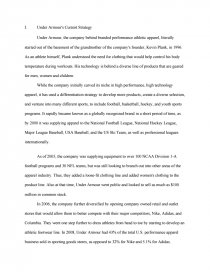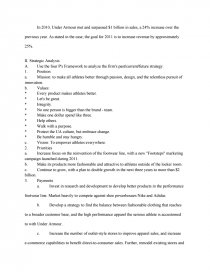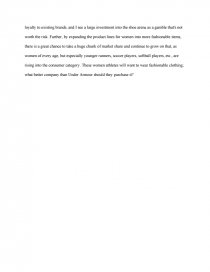Under Armour's Current Strategy
Essay by anotherpaperdone • February 4, 2013 • Case Study • 1,107 Words (5 Pages) • 1,787 Views
I. Under Armour's Current Strategy
Under Armour, the company behind branded performance athletic apparel, literally started out of the basement of the grandmother of the company's founder, Kevin Plank, in 1996. As an athlete himself, Plank understood the need for clothing that would help control his body temperature during workouts. His technology is behind a diverse line of products that are geared for men, women and children.
While the company initially carved its niche in high performance, high technology apparel, it has used a differentiation strategy to develop more products, create a diverse selection, and venture into many different sports, to include football, basketball, hockey, and youth sports programs. It rapidly became known as a globally recognized brand in a short period of time, as by 2000 it was supplying apparel to the National Football League, National Hockey League, Major League Baseball, USA Baseball, and the US Ski Team, as well as professional leagues internationally.
As of 2005, the company was supplying equipment to over 100 NCAA Division 1-A football programs and 30 NFL teams, but was still looking to branch out into other areas of the apparel industry. Thus, they added a loose-fit clothing line and added women's clothing to the product line. Also at that time, Under Armour went public and looked to sell as much as $100 million in common stock.
In 2006, the company further diversified by opening company owned retail and outlet stores that would allow them to better compete with their major competitors, Nike, Adidas, and Columbia. They went one step further to dress athletes from head to toe by starting to develop an athletic footwear line. In 2008, Under Armour had 43% of the total U.S. performance apparel business sold in sporting goods stores, as opposed to 32% for Nike and 5.1% for Adidas.
In 2010, Under Armour met and surpassed $1 billion in sales, a 24% increase over the previous year. As stated in the case, the goal for 2011 is to increase revenue by approximately 25%.
II. Strategic Analysis
A. Use the four P's Framework to analyze the firm's past/current/future strategy.
1. Position
a. Mission: to make all athletes better through passion, design, and the relentless pursuit of innovation.
b. Values:
* Every product makes athletes better.
* Let's be great.
* Integrity.
* No one person is bigger than the brand - team.
* Make one dollar spend like three.
* Help others.
* Walk with a purpose.
* Protect the UA culture, but embrace change.
* Be humble and stay hungry.
c. Vision: To empower athletes everywhere.
2. Priorities
a. Increase focus on the reinvention of the footwear line, with a new "Footsteps" marketing campaign launched during 2011.
b. Make its products more fashionable and attractive to athletes outside of the locker room.
c. Continue to grow, with a plan to double growth in the next three years to more than $2 billion.
3. Payments
a. Invest in research and development to develop better products in the performance footwear line. Market heavily to compete against shoe powerhouses Nike and Adidas.
b. Develop a strategy to find the balance between fashionable clothing that reaches to a broader customer base, and the high performance apparel the serious athlete is accustomed to with Under Armour.
c. Increase the number of outlet-style stores to improve apparel sales, and increase e-commerce capabilities to benefit direct-to-consumer sales. Further, remodel existing stores and add floor space at some current retailers (Dick's Sporting Goods, Sports Authority).
4. Performance
a. Increased revenue and margin from footwear line.
b. Improved company image as customer
...
...




